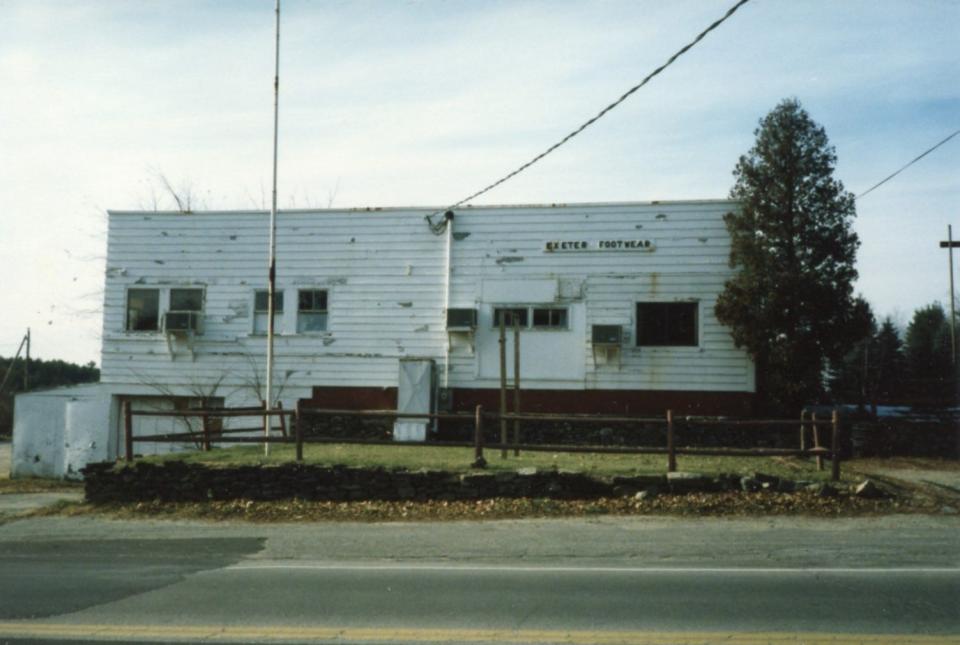Historically Speaking: The rise and fall of Exeter Footwear
In the early 1960s, Exeter’s once-thriving shoe industry was waning. The two shoe factories – Wise Shoes on Front Street and Alrose Shoes on Rockingham Street – were both finding it hard to compete in a growing international market. It surprised everyone when a new shoe company set up shop in Exeter on Court Street.
The old building at 93 Court Street had started its life in 1940 as a Ford dealership owned by Wendall Battles. It wasn’t much to look at, but then, it didn’t need to be. Battles ran his business until his retirement in the 1950s. The building was afterward the home of Patterson Ford sales, run by Frank Patterson, Donald McFarland, and Henry McFarland. By 1960, the building’s car dealership days came to an end when the business moved to Portsmouth Avenue.

For a slim few years, 93 Court Street became the home of Cadillac Pins, a firm that produced bowling balls and pins. Over the course of two years, the firm frequently advertised for workers who could operate a wood lathe, indicating that the bowling pins were hand-turned. They also advertised for “a girl to do general office work,” on more than one occasion. Given the New England predilection for bowling, it’s a bit surprising that, in December of 1962, the firm was placed into involuntary bankruptcy.
The building did not stay vacant long. In May of 1963, it was announced that a shoe factory would be moving in. “Another new industry is slated to open in Exeter in the near future. President, treasurer, and general manager of the new Exeter venture is Alfred Rindler, 41, former executive with a large shoe firm in Newburyport, Mass., where he resides with his wife and two children.”
Historically Speaking: What happened to Exeter’s 14 schools?
Rindler ran Ruth’s Shoes in Newburyport, which made high-end ladies’ shoes. One of the first employees he hired in Exeter was a young Ted Adamski, a trimmer and edge setter who was working for United Shoe at the Wise Shoe shop. Wise was having difficulty finding enough contracts for its piece workers.
The new business, called Exeter Footwear Company, specialized in sandals and would not be in direct competition with the other shoe shops in town. Ted stopped by as Rindler was setting up. “Kid,” Adamski recalls him saying, “we don’t have the machines yet – stop by in a few days.” Rindler was not sure if the youthful appearing Adamski was up for the job. Instead of an interview, he had him trim several pairs of shoes to prove he could do the work. As a second-generation shoe worker, Adamski was easily able to manage the machinery.
During the fall and winter of 1963-64, he routinely finished his shift at Wise and then reported for a few more hours at Exeter Footwear. When there was too much for him to finish, he convinced his father, Nicky, to tag along and help with the edge setting. The elder Adamski found this to be a perfect retirement job. Ted’s boss at Wise told him not to go full-time with Rindler, convinced that sandals were nothing more than a fad. When the work dropped off at Wise, Ted took a full-time position at Exeter Footwear and stayed with the company until Rindler retired in 1981 and through new ownership until the business closed in 1986.
Historically Speaking: How Exeter experienced the roaring twenties in 1923
The sandals made at Exeter Footwear were all Goodyear stitched, a superior method according to Adamski. Contracts came in from Bass, Sebago, Stride Rite and Etienne Aigner. Adamski didn’t have a bad thing to say about Alfred Rindler. “He was the kindest and most generous man, and I was lucky to work for him.” The business had a seasonal nature – they would be busy from August to June, and then things would drop off in the summer. Most of the employees were women who found having the summer months off to be helpful with childcare. Adamski recalls that many had worked at Ruth’s Shoes in Newburyport and had followed Rindler to Exeter when he opened the new shop. Rindler hired Adamski to work as a gardener at his home in Newburyport during the summer.
Exeter Footwear closed its doors in April of 1986. When Ted reported to work, the new owners told him not to turn his machine on. “We’re done,” he was told. There was no severance or accrued vacation time paid. It was a sad end to a job Adamski had loved. When asked if he’d go back, he said, “I’d walk there on broken glass.”
The old building was sold and re-sold a few times over the years and eventually torn down. Wise sold its factory to Nike in 1972, but after that, Exeter’s history of shoemaking ended with the closure of Alrose Shoes in 2000.
Barbara Rimkunas is the curator of the Exeter Historical Society. Support the Exeter Historical Society by becoming a member. Join online at www.exeterhistory.org.
This article originally appeared on Portsmouth Herald: Historically Speaking: The rise and fall of Exeter Footwear

